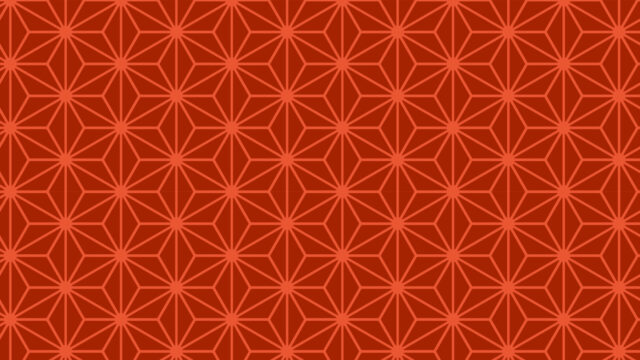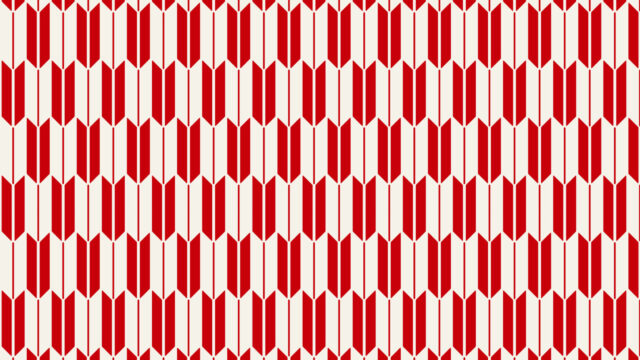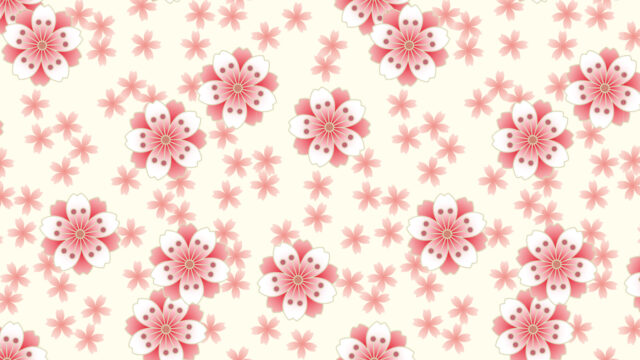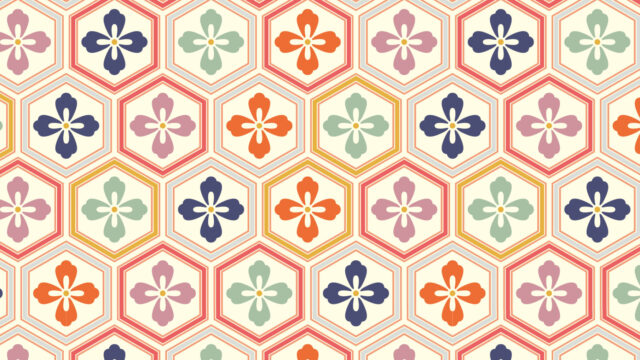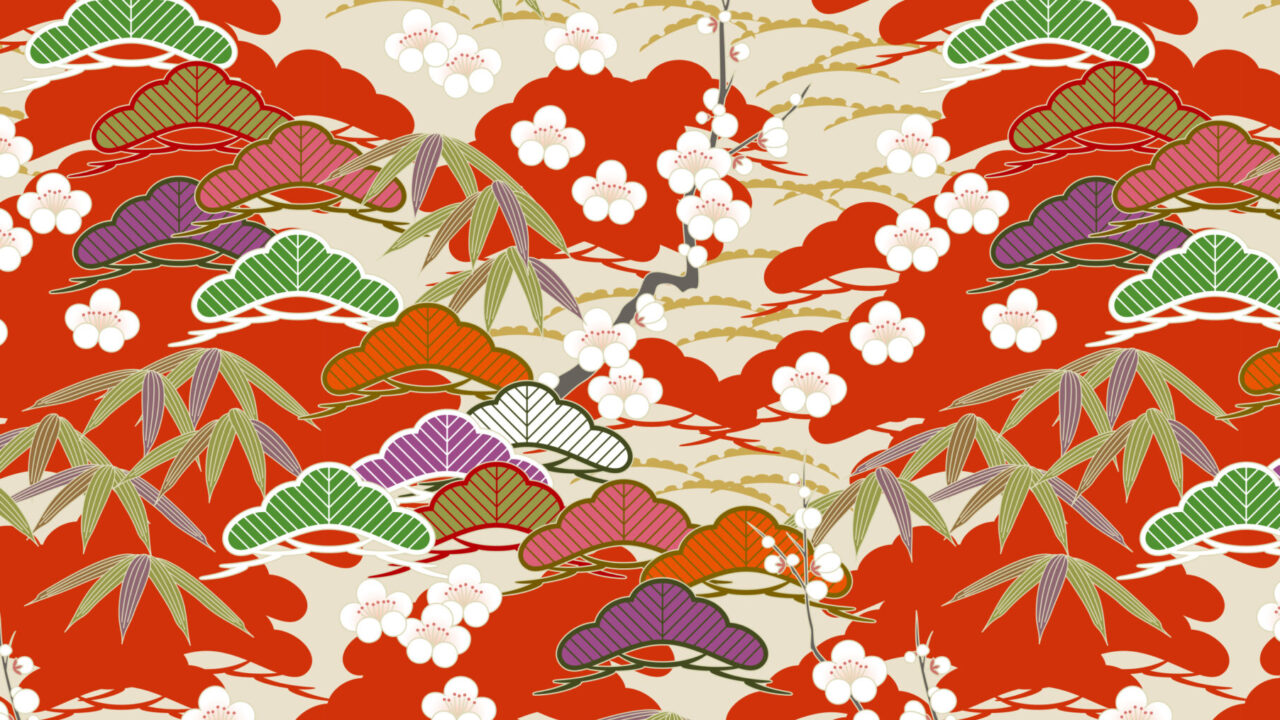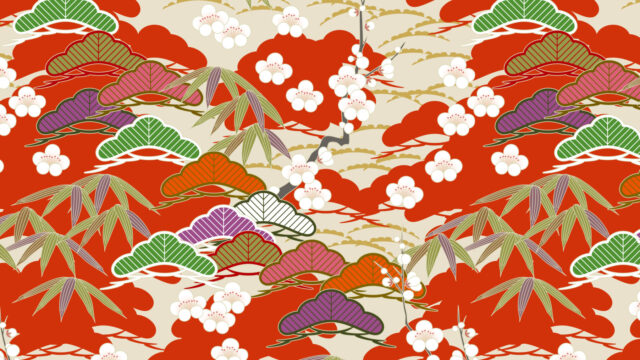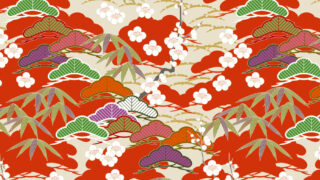長襦袢
着物の下、肌着の上に着ます。着物を汗や皮脂から守ります。体温調節の役割もします。
袷と単衣があり、10月~翌年5月までが袷、6月~9月が単衣といわれていますが、、最近は温暖化対策もありますし、暑くないように、袖だけ袷にした無双仕立てなどもあります。
長襦袢と言うと対丈(おはしょりがない着方)を思い浮かべます。その他に二部式長襦袢というのもあります。
対丈長襦袢
自分の体にあった長さなので、おはしょりがない着方をします。
木綿
洗えます。着物も木綿だと裾がもたつくこともあります。
ポリエステル
洗えます。サラッとしています。夏の汗などが気になることも。
お値段は2000円ぐらい~
麻
洗えます。夏用の感じがしますが、温暖化もあり、年中着ることができます。
お値段は8000円ぐらい~
絹
裾さばきがよく。体に馴染みます。
お値段は8000円ぐらい~(未仕立て、洗える絹など条件がいろいろです。)
お値段は参考程度です。
二部式長襦袢
着物の上下が分かれています。素材は、ポリエステルが裾よけと袖、綿が身頃に使用されています。
特徴
- 裾よけを着ないです。
- 胸が大きい方は二部式になっている分凹凸の切り替えがしやすいかもです。
- 夏の着物の時など、身頃の裾が線になって着物に出るおそれがあります。
- 身頃とその他の部分の色が違うと夏着物の時透けて見える色が部分で変わってしまうことも。
お値段は2000円ぐらい~
お値段は参考程度です。
長襦袢は着物から袖などで見えますし、半衿をつけるところでもあります。最初にも書きましたが、汗などから着物を守ったり、体温調節の役割もになってます。いろんな役割に応えるべく、素材や形が本当に様々です。
自分が楽しみたいことは最大限楽しんで、苦手なこと(例えば、半衿付けとか衣紋抜き)はサポートしてくれる長襦袢を選ぶと良いと思います。
Hadajyuban
Nagajyuban is worn between kimono and underwear. Protect your kimono from sweat and sebum. It also regulates body temperature.
Nagajyuban has hitoe(be made of apiece of cloth) and awase( two pieces of fabric overlap).
fund mental
Awase (袷) October ~ May of the following year
Hitoe (単) June ~ September
The hot months are long there days. Please decide on Nagajyuban according to your physical condition.
If you are still curious,there are also musou-sitake(It is hitoe nagajyuban, but there is a awase only on the sleeve)
Nagajyuban has Tuitate- nagajyuban and Nibusiki- nagajyuban.
Tuikake- nagajyuban
It is a Nagajyuban that fits your height. So there is no ohasyori(おはしょり).
Cotton
You can wash it. If Nagajyuban and kimono are made of the same cotton material, it may be doffocult to walk.
Polyester
Washable. Some people are worried about sweat in summer.
It is costs about 2000 yen or more.
Hemp
washable. It is not for summer, it can be worm all year round.
It is costs about 8000 yen or more.
silk
It fits your body. It is easy to move.
It is costs about 8000yen or more.(Untailored, washable silk, etc. Vary in conditions.)
※The price is just for reference.
Nibusiki-nagajyuban
The top and bottom of the Nagajyuban are separated. It is made of cotton where it fit the upper body. The lower body and sleeves are made of polyester.
Characteristic
- Keep one`s susoyoke(裾よけ) off
- If you have a big chest, it is easy to switch between the waist and chest cloth.
- When the kimono is transparent in summer kimono, you may see the end of the cloth on the upper body.
- If the sleeves and body colors are different under the same conditions as above, the difference may be seem from the outside of the kimono.
It is costs about 2000 yen or more.
※The price is just for reference.
Nagajyuban has role and fun. Please choose nagajyuban to help you wish difficulties.( For example, sew the haneri(半衿),wear the back of the collar beautifully, etc)
長襦袢(対丈)着方 Bagajyuban how to wear
長襦袢をはおり背骨と背中心をあわせます。(これが一番大事です。)片手は衿先、片手は背中確認。
Align the center of the back of the nagajyuban with the spine.
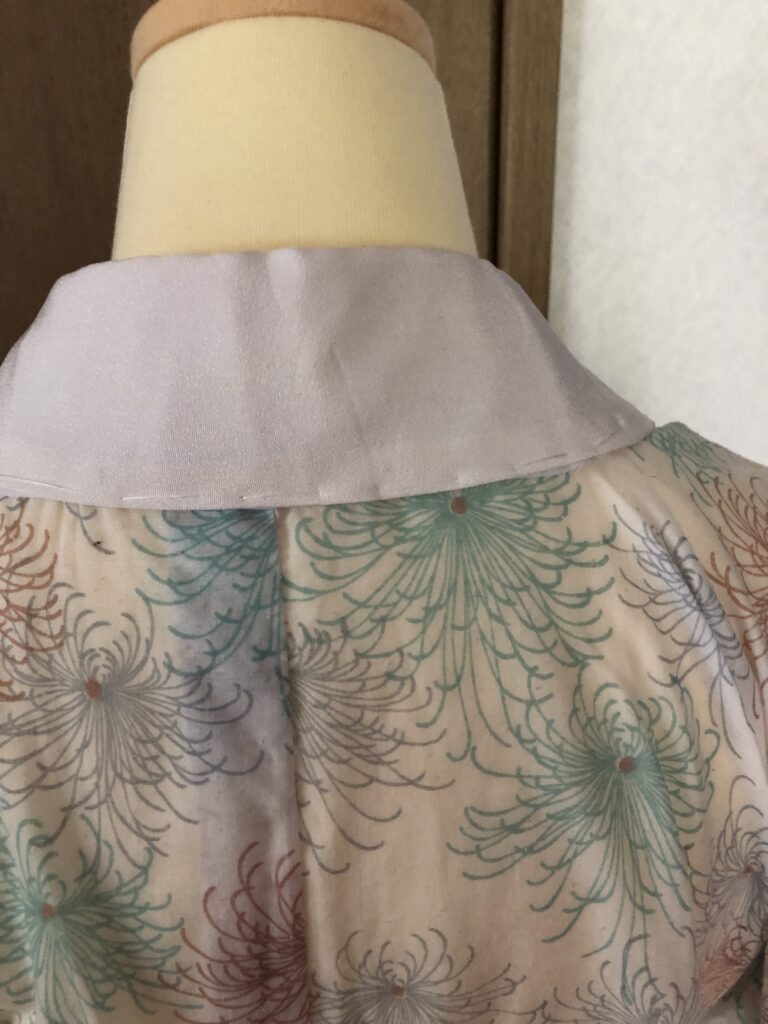
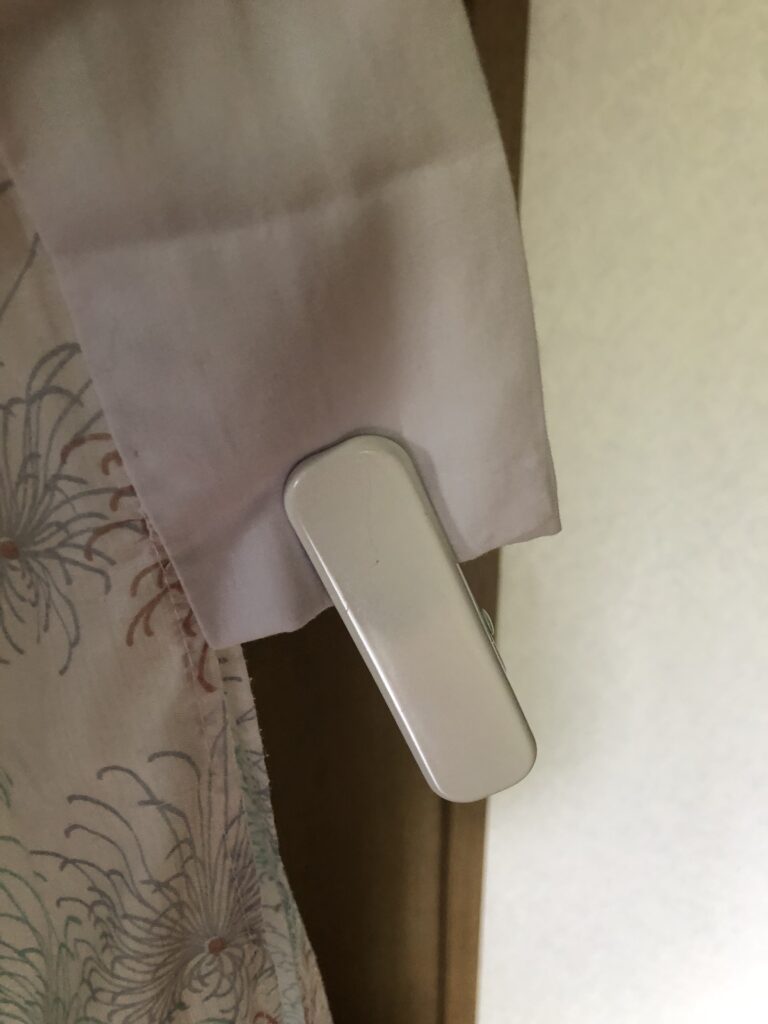
衿先を持ってきて衿を真っ直ぐ伸ばします。
Align the tip of the collar.
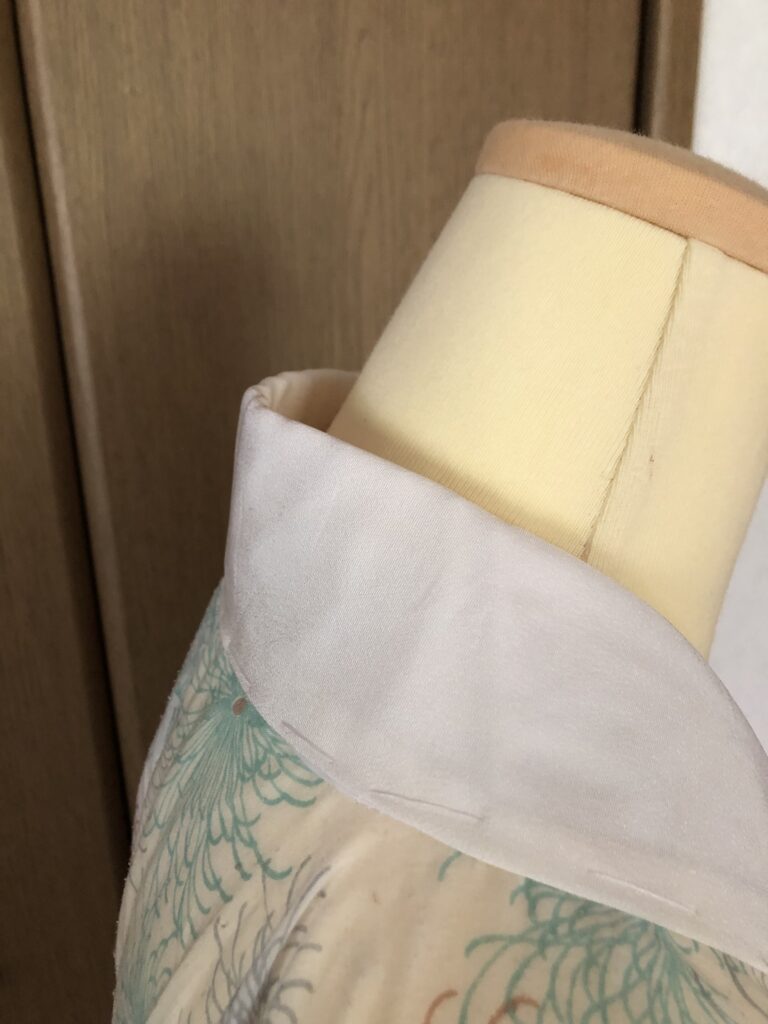
後ろは背中心を合わせたまま首に付けておきます。
Put a nagajyuban on the back of your neck.
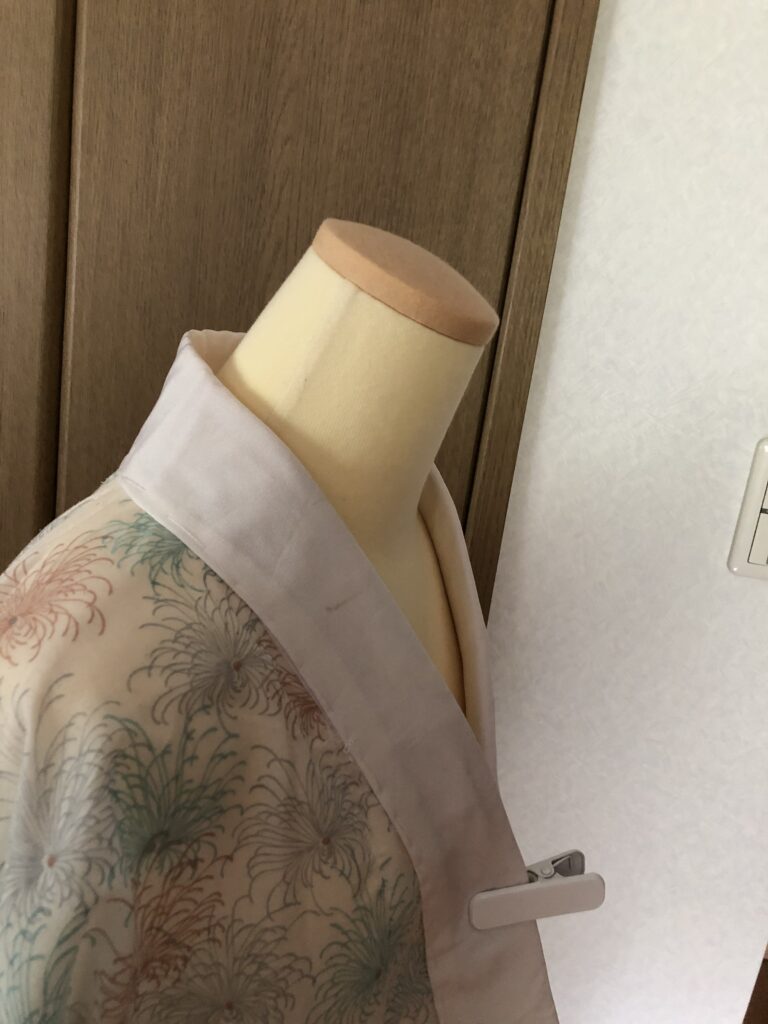
前を持っている手は衿先からの衿あわせするあたりに持ち替えます(クリップ辺り)
Hold the collar with one hand( in the clip position).
背中心を持っている方の手を、ゆっくりと後ろに引いて衣紋を抜きます。体になじませるようにゆっくりです。
Hold the center of the back of the nagajyuban with one hand and lower it. Please work slowly so that it fits into your body.
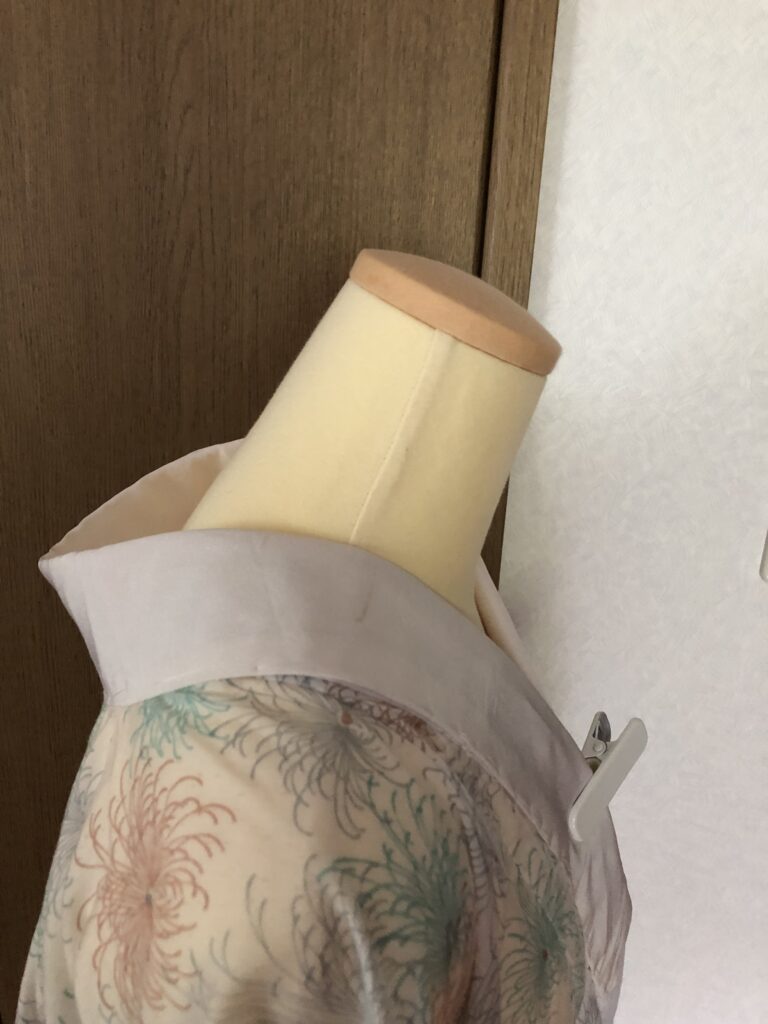
目安程度ですが
おしゃれ、普段着物はこぶし半分
礼装の時はこぶし1つ分
Standard
Stylish, casual kimonos half-fist
formal kimono fistful
抜いた衣紋を動かさないように衿あわせします。左右対称に胸に置くように、衿が体の中心でⅤ字にします。
Adjust the front of the collar without moving the back of the collar. Let`s make it V symmetrically.
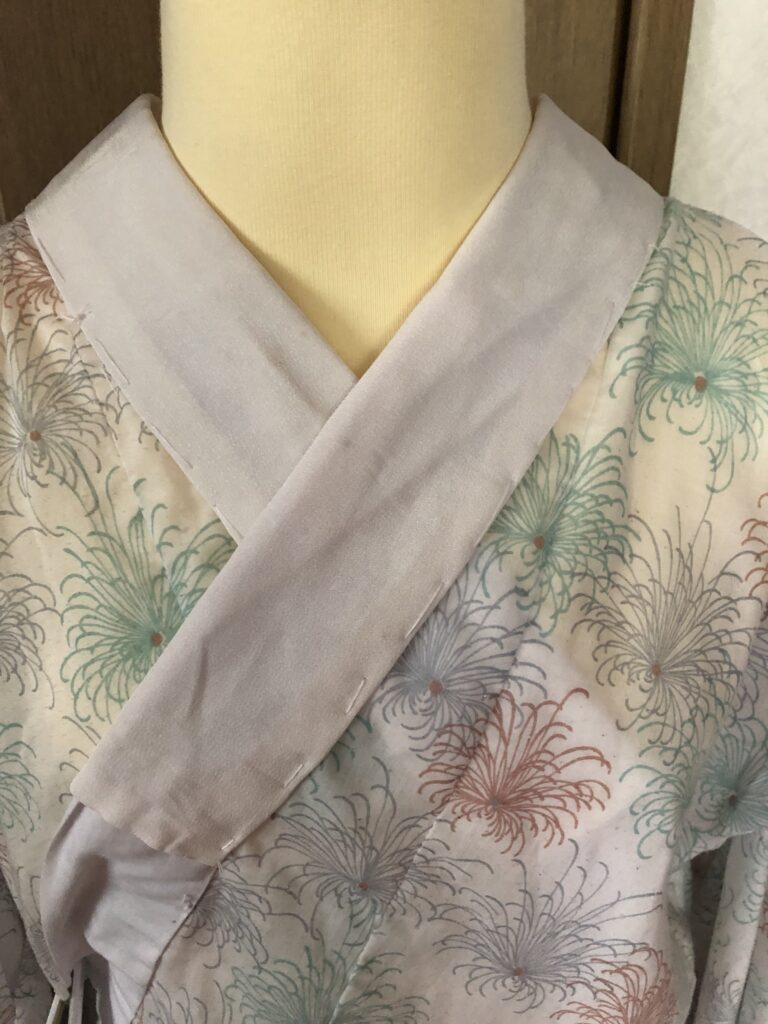
あわせた衿が動かないようにに片手で押さえて、むな紐を持ってきてアンダーバストで結びます。
Press with one hand so that the collar does not move. Tie it with a munahimo(むな紐) under your chest.
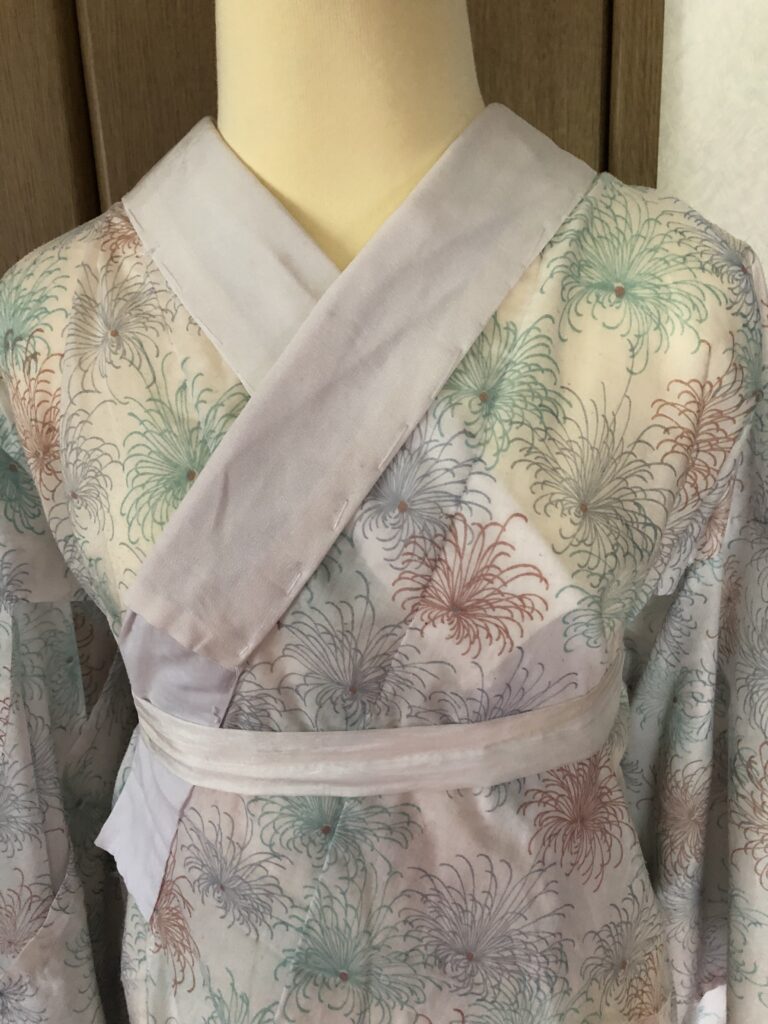
むな紐は後ろで交差させ、前に持ってきます。紐を結ぶときは、痛くならないようにゆっくりと結んでください。
Please tie the munahimo(むな紐) slowly so that it does not pain when you tie it.
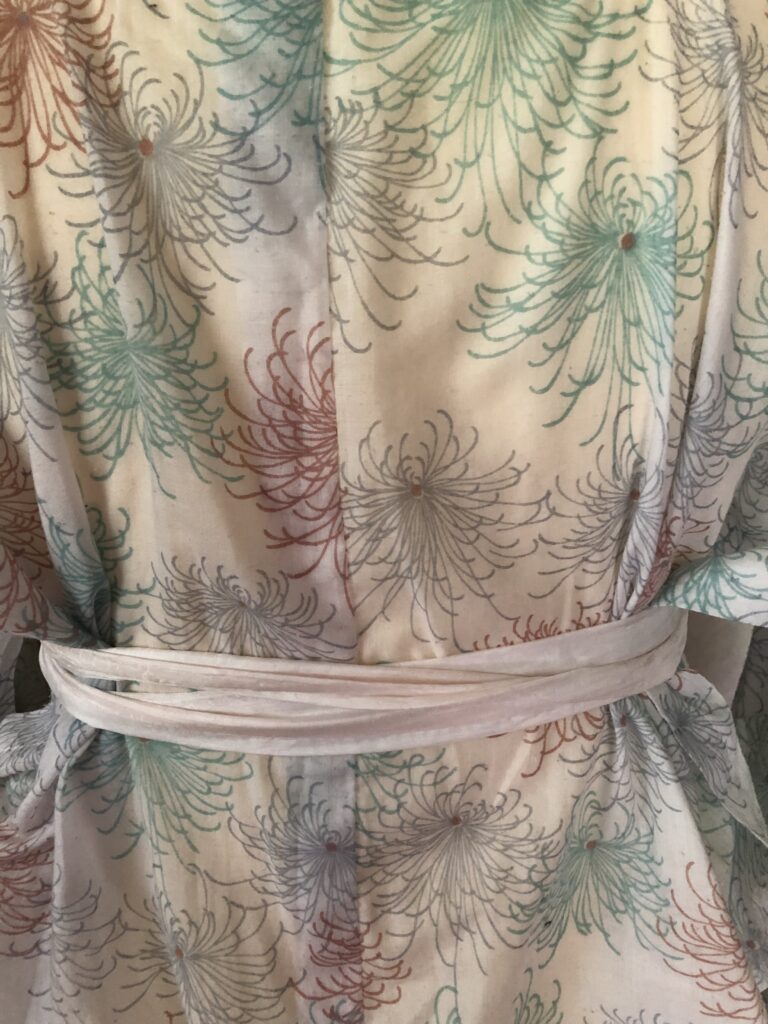
前で二回巻いて交差させて紐の端も巻きます。もしくは結ぶ。苦しくないように紐と長襦袢の間に指1~2本分はいるくらいにします。
Wrap the munahimo(むな紐) twice. Tie the munahimo(むな紐) or wrap the end of the munahimo(むな紐). Let`s tie it up so that it does not painful. For example you can put one or two fingers between your body and the string.
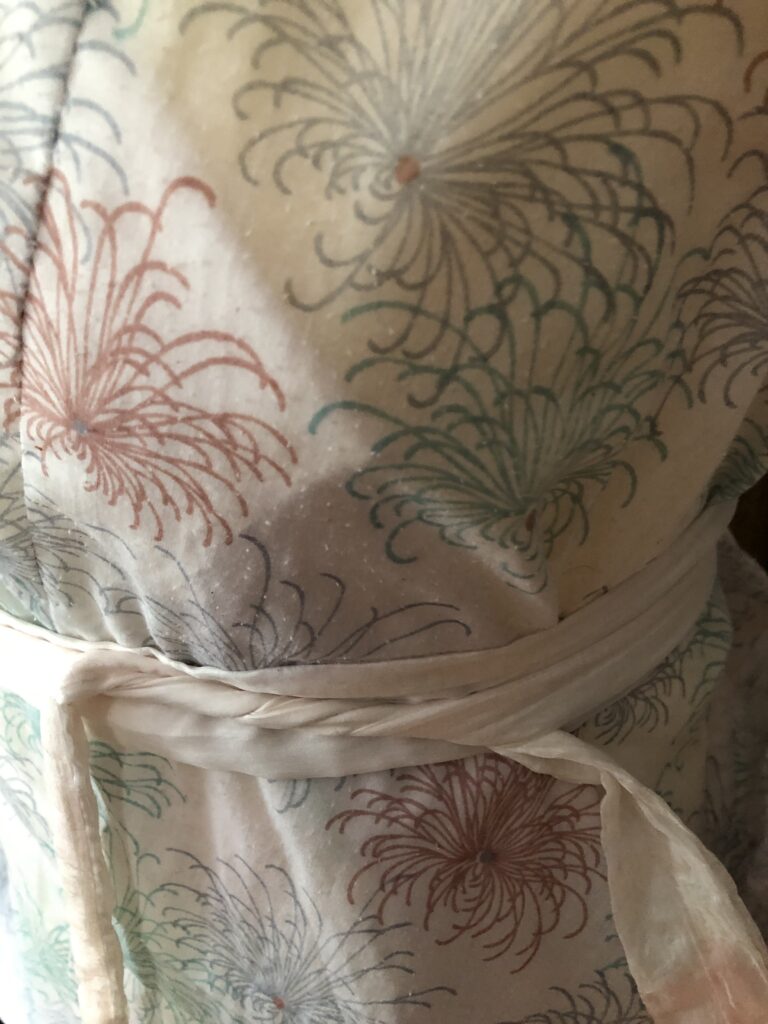
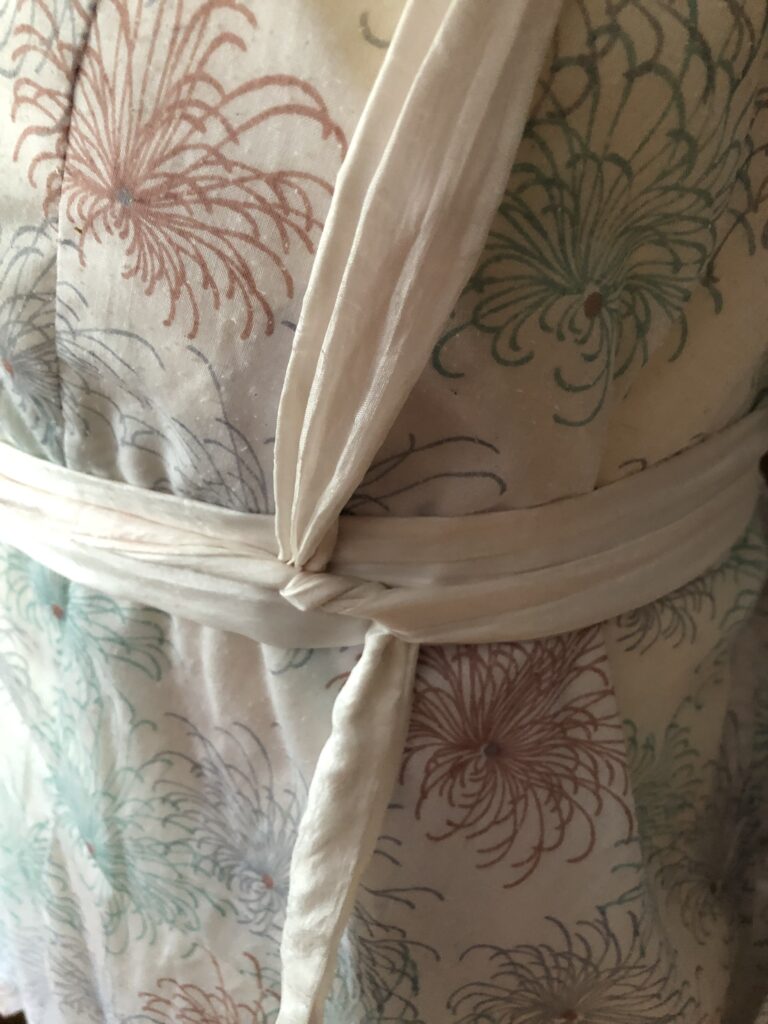
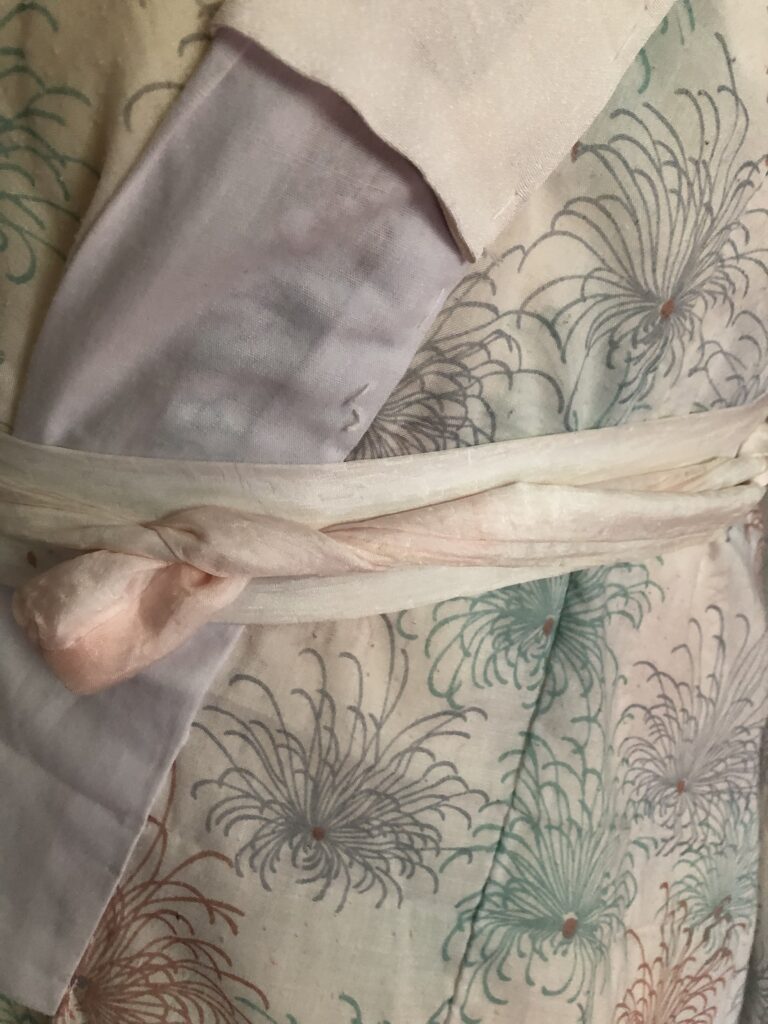
シワを取ります。背中のむな紐下から両手で下に引っ張ります。ゆっくりと。(引っ張り方で衣紋の形が変わってきます。好きな形にしてくださいね。)
I will get rid of wrinkles. Slowly pull the kimono from under the munahimo(むな紐).( The shape behind the collar changes according to the direction of pulling the cloth. Please make it your favorite shape.)
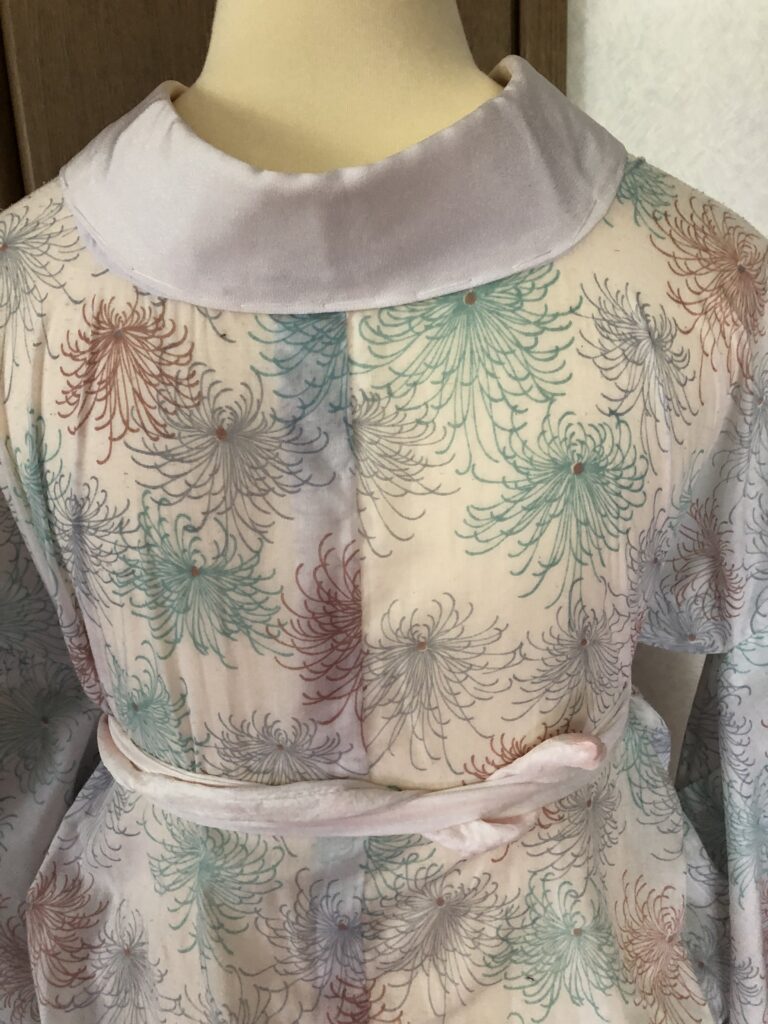
シワが気になるなら、親指とか人差し指とか紐と長襦袢の間に差し込んで、背中心から左右対称に脇へシワを運びます。
Stretch wrinkles from the center of your back to both sides.
シワを持ってきて、身八ッ口のが気になるなら、前身頃の方を後ろ身頃にかぶせてスッキリさせます。
If you are worried about kimono wrinkles under your armpit, put the front cloth on the back cloth to remove wrinkles.
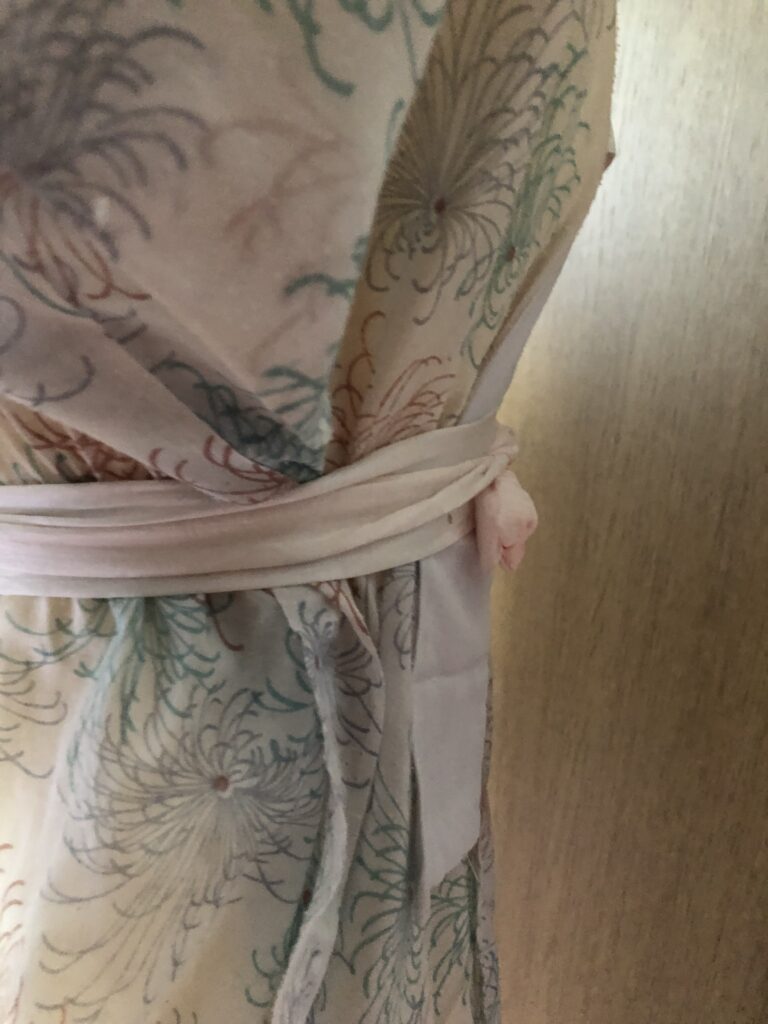
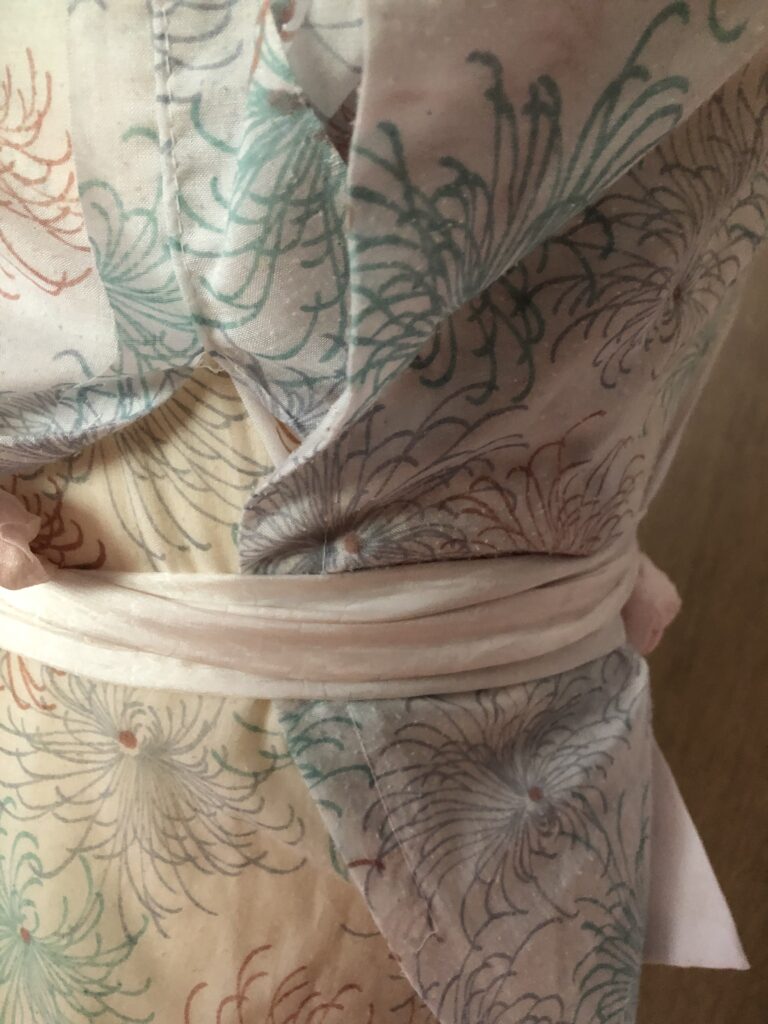
二部式長襦袢着方 Nibusiki-nagajyuban
裾よけ
上前(左手)を右腰骨にあわせて、残りは全て下前(右手)のほうへ引っ張ります。
この作業は上前を決めるだけの作業です。
Align the left end of the cloth with the right hipbone. Pull the rest of the cloth to your right.
This is work of locating the uwamae(上前).
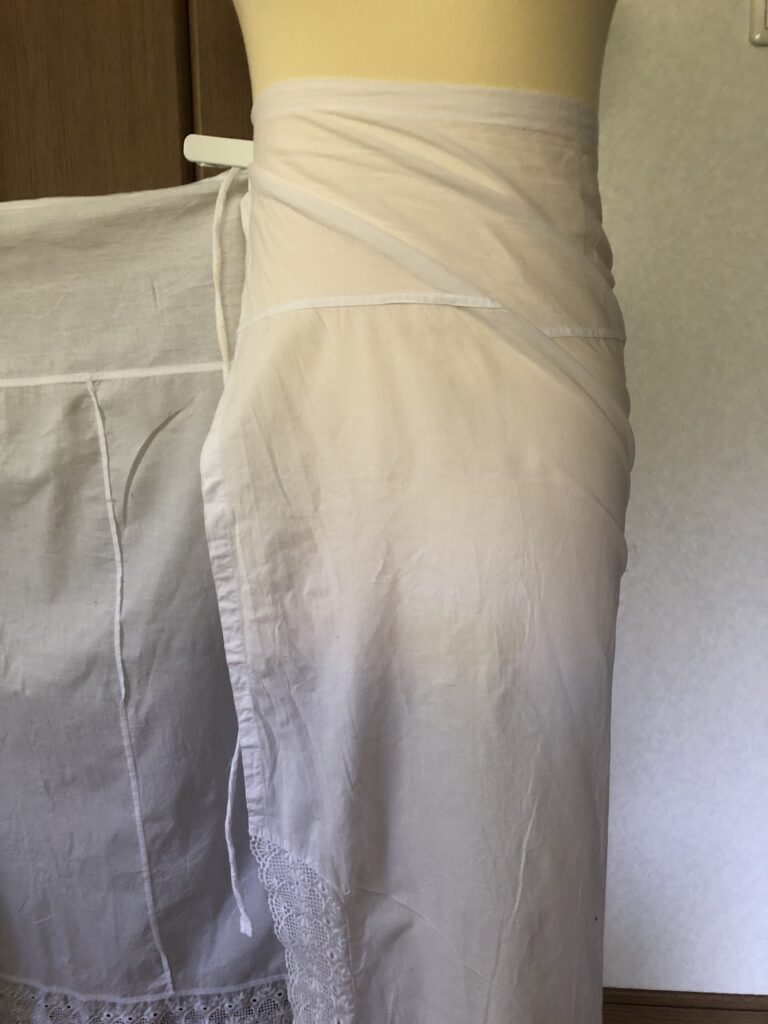
上前(左手)を右腰骨から離して下前(右手)を左腰骨の方へ持っていき、5㎝上げます。
裾よけが長い場合はこのように折り返した方が良いです。あまり後ろまで布がいくと、布が絡んで足さばきが悪くなります。
Once positioned, take the cloth at the right end to the left hipbone. Raise the edge about 5 cm up.
If the cloth is long, please do it like this. If you do that, your feel and cloth wont not get tangled.
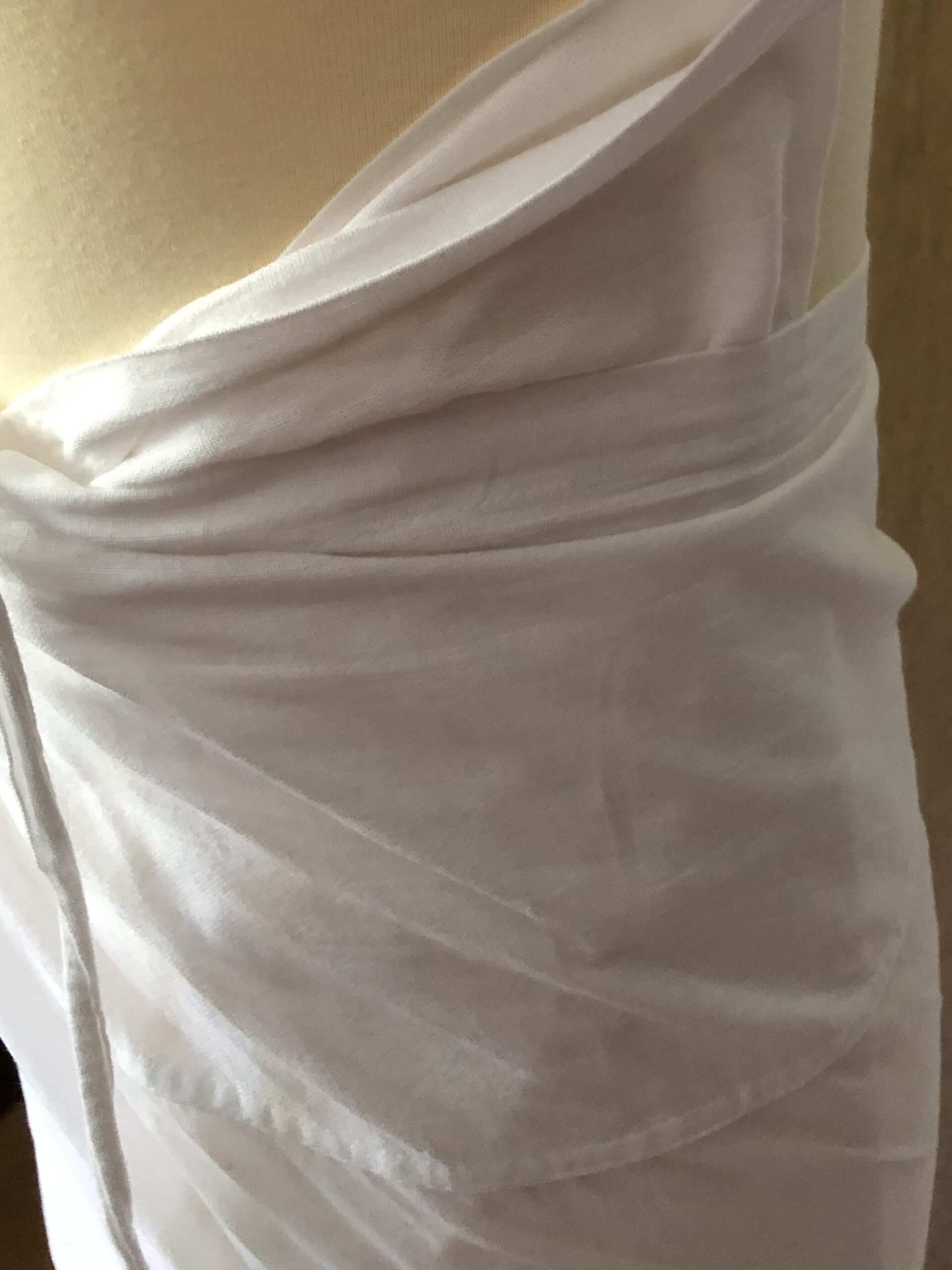
上前(左手)を右腰骨に持っていって最後の端を5㎝上げます。
Take the cloth on the left end to the first position. Raise the end about 5 cm up.
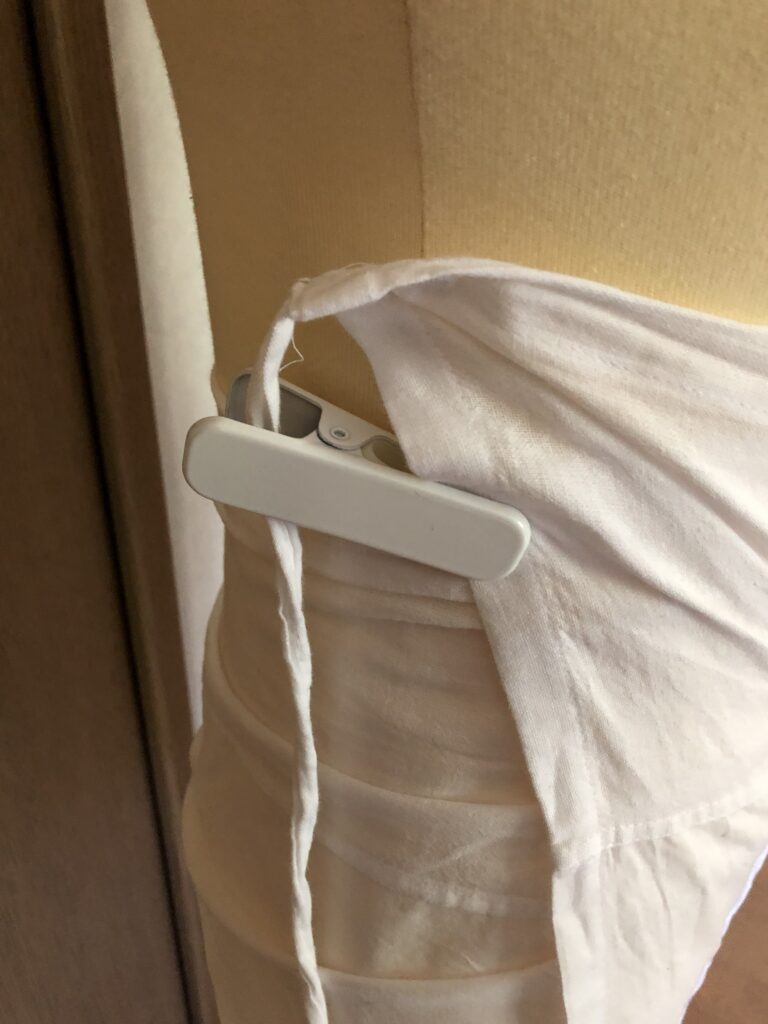
両端5㎝上げた部分が三角形に飛び出しています。その部分を下におります。
Fold both ends down.
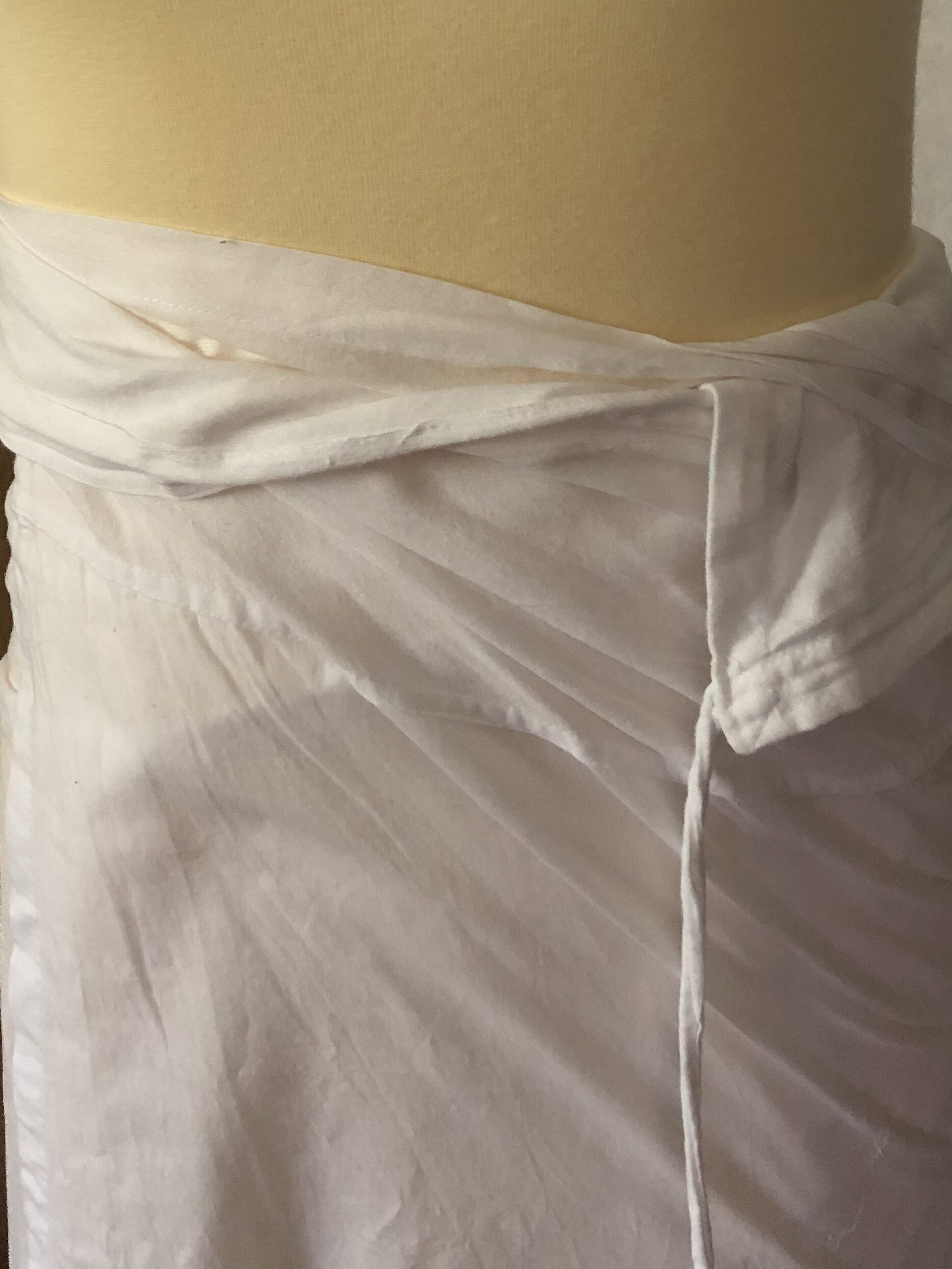
紐を体一周させて、蝶々結びまたは、紐同士を2回巻いて反対に持っていって、紐の端を2回ほど巻きます。
The string goes around the body, and tie in a bow or wrap the string twice, twist the wrap part.
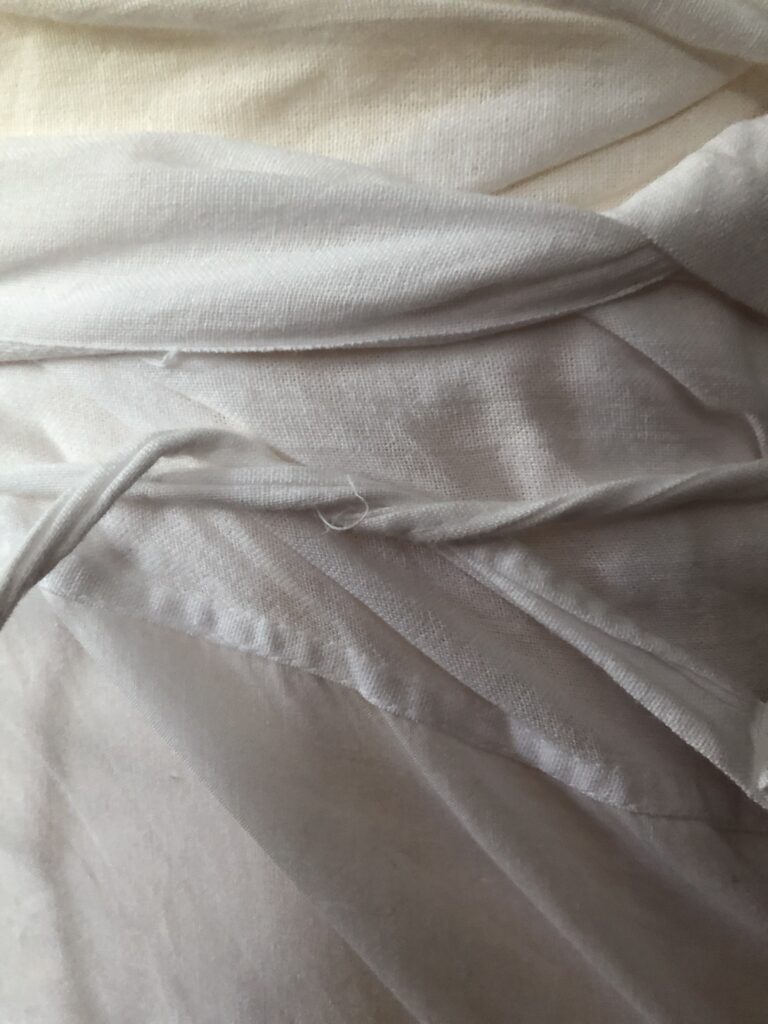
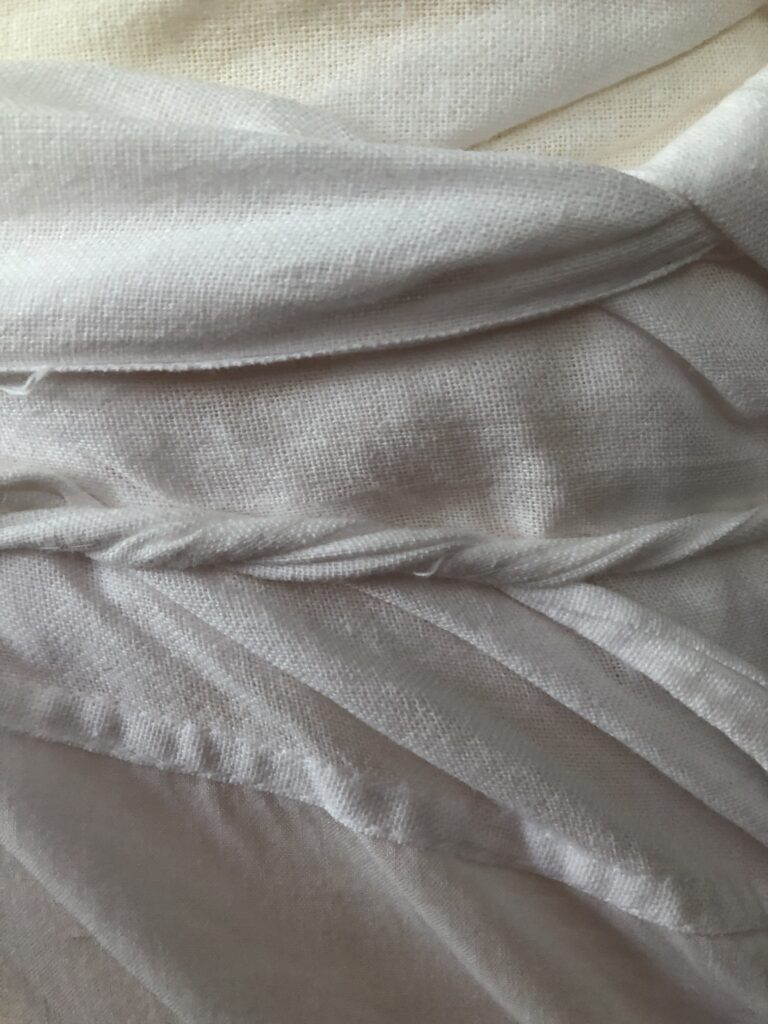
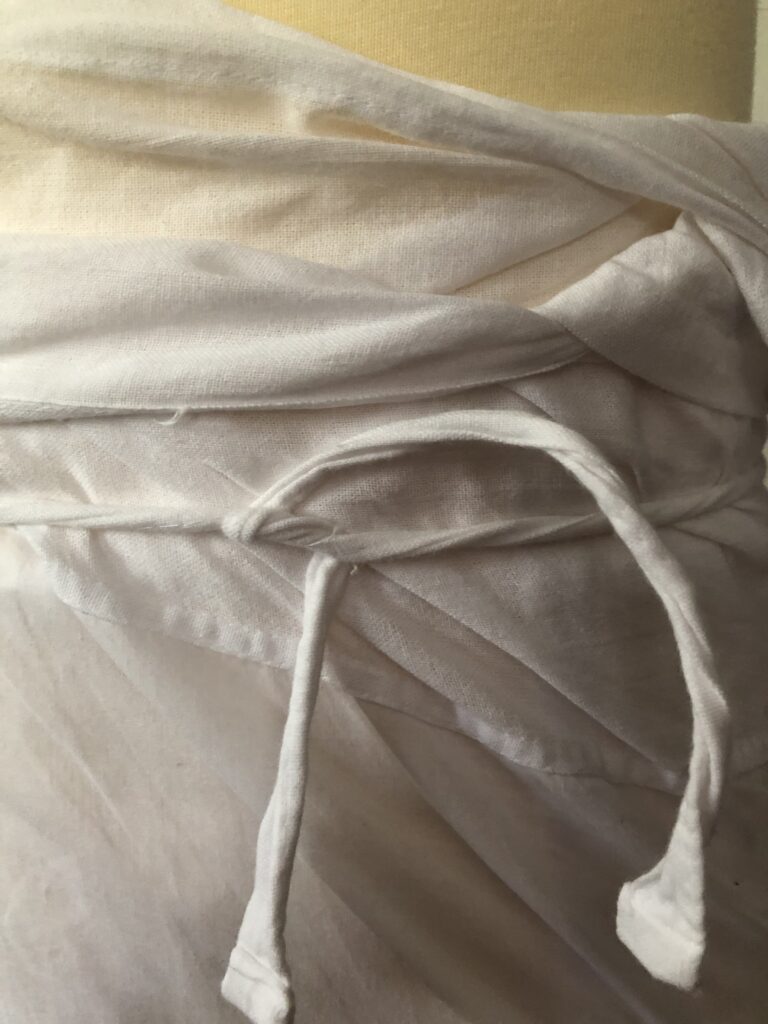
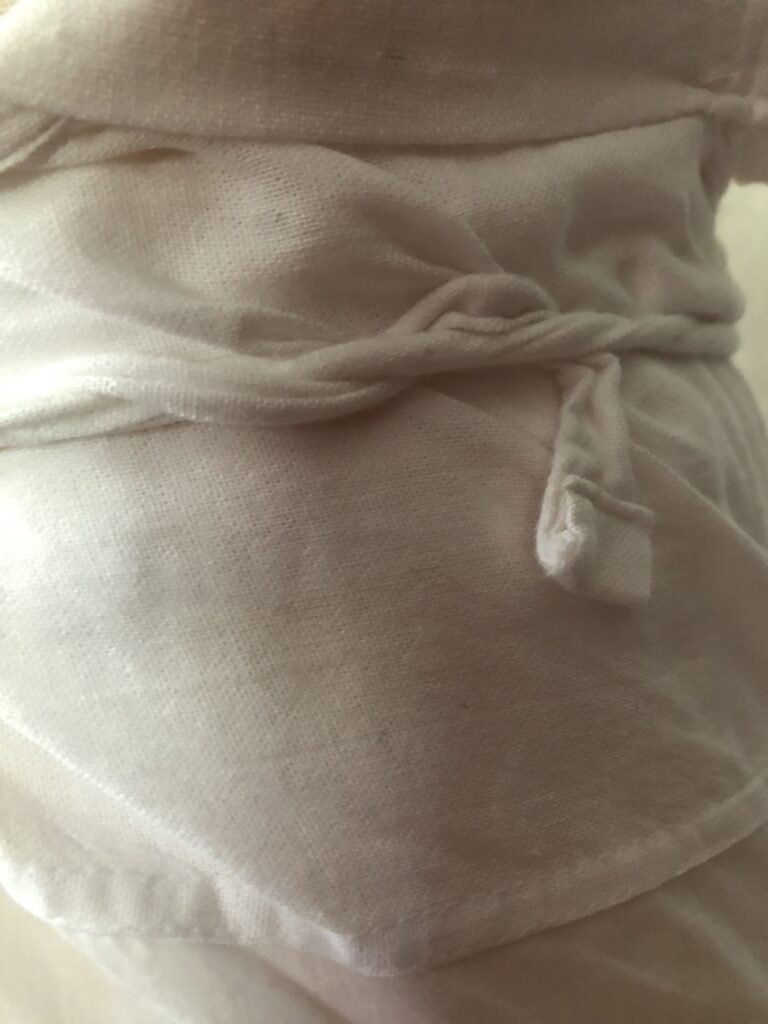
両端5㎝上げた分裾が下に向かって細くなります。(裾すぼまり)
It gets smaller toward the hem.
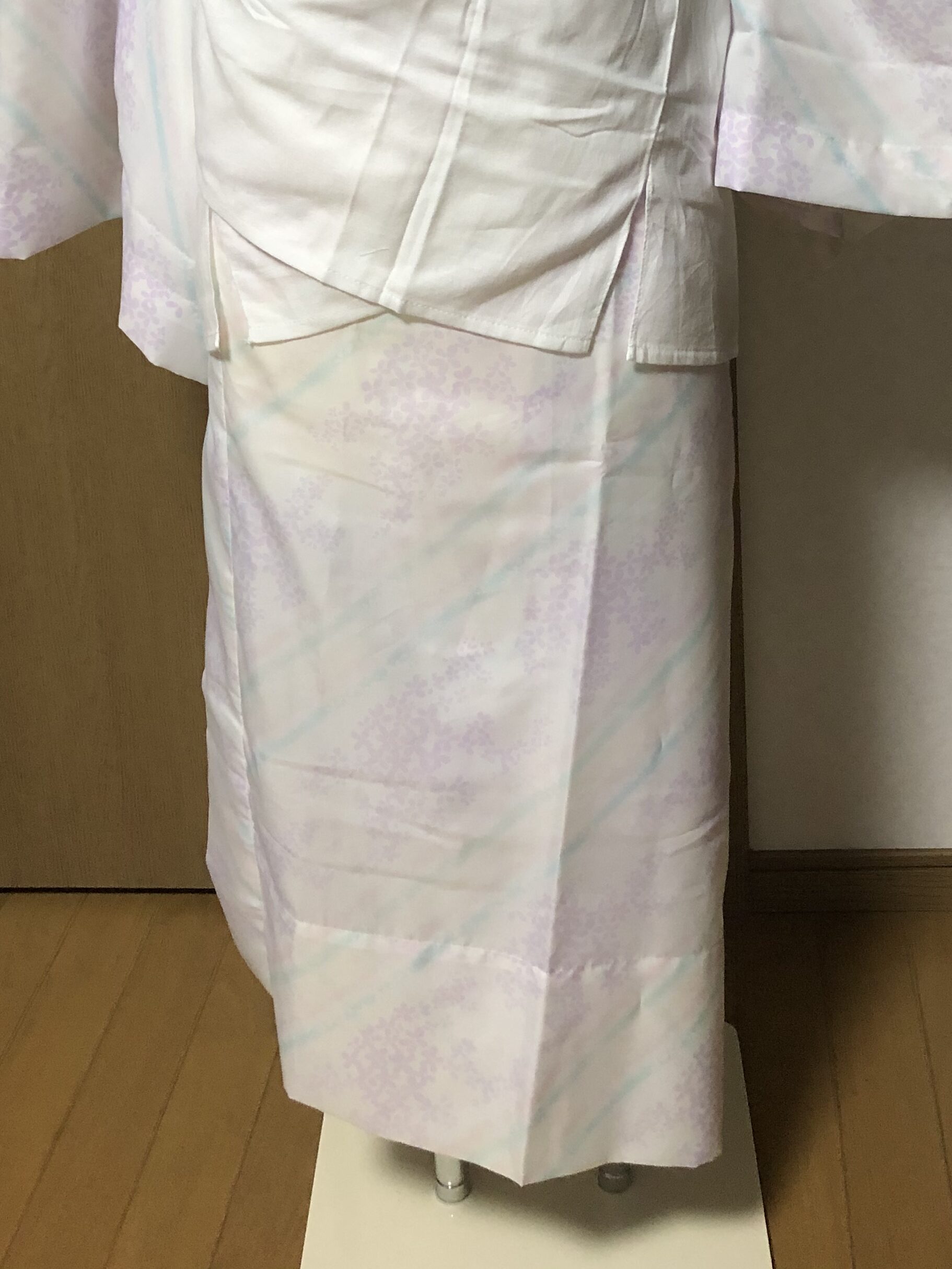
身頃
長襦袢の着方と同じです。
It is same as nagajyuban.
出来上がり Completion
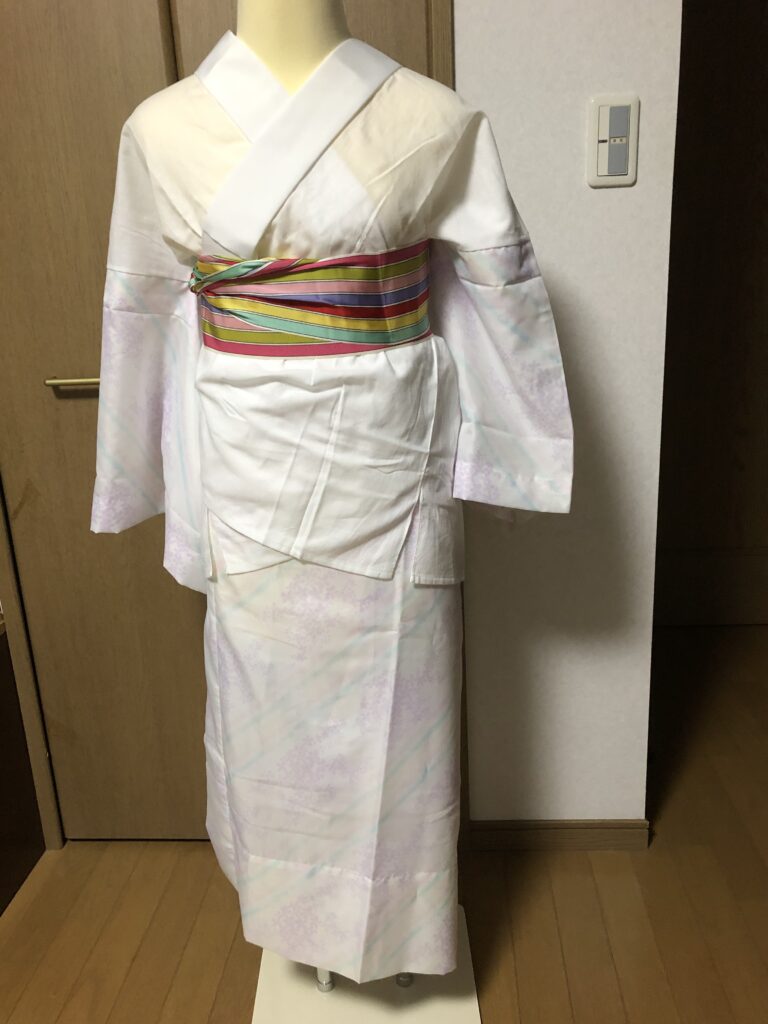
夏着物の時、線が気になるならこうすると良いでしょう。
If you are curious if you can see the nagajyuban on your upper body in summer kimono, let`s do it like a picture.
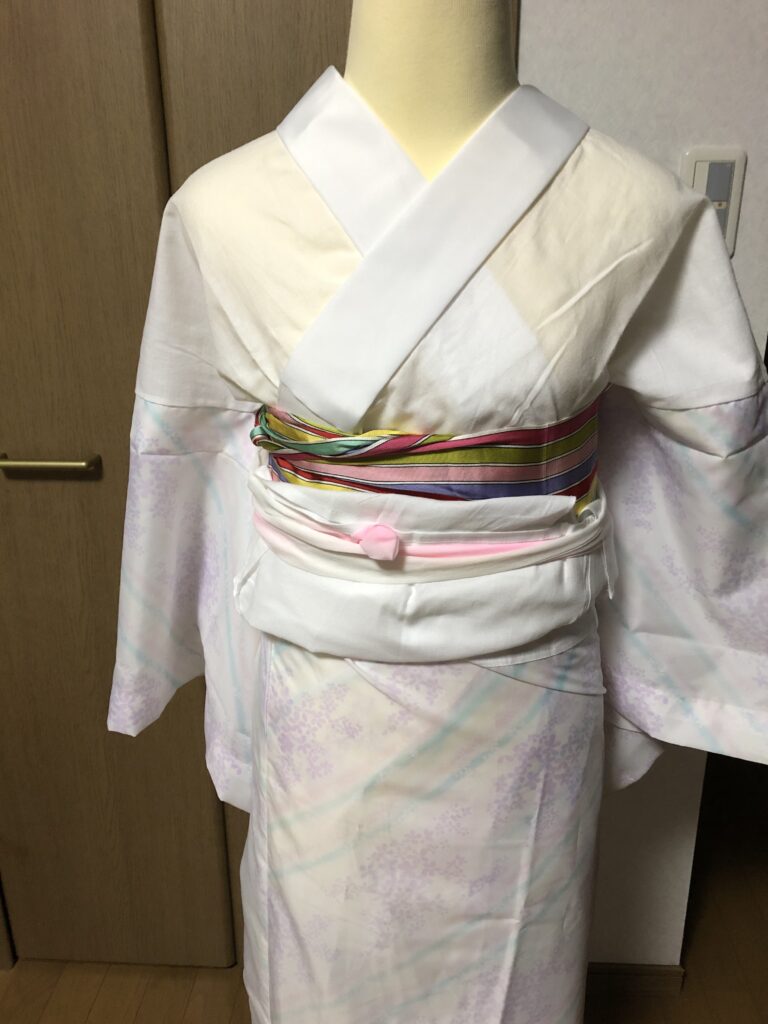
長襦袢の着方他にもいろいろありますが、苦しくないように自分なりの手順見つけて楽しんでください。
There are many steps to wear nagajyuban. Please find a way to wear it that suits you so that it dose not pain.
最後まで読んでいただきありがとうございました。
I am sorry for poor English.
Thank you for reading through to end.
